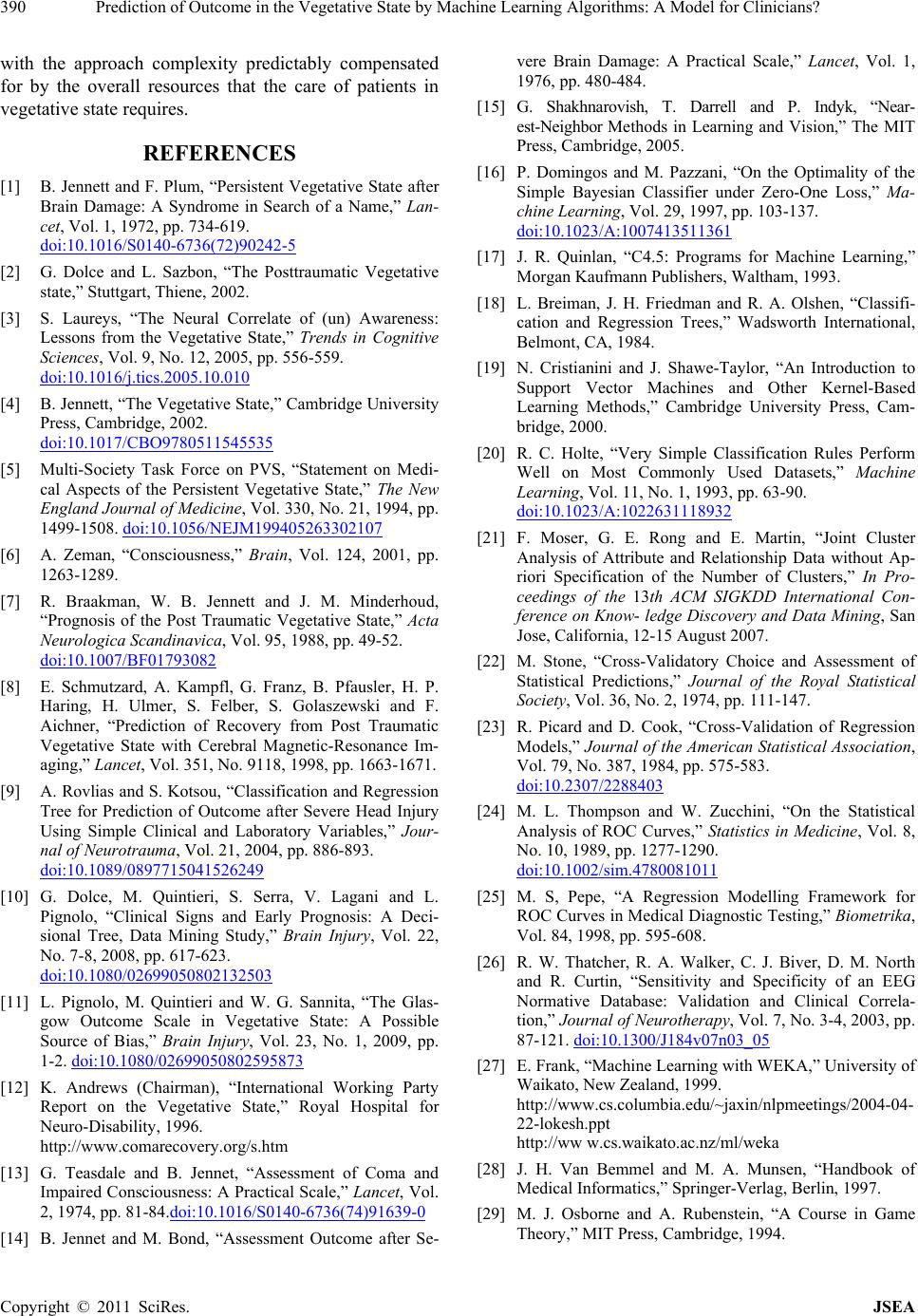
Prediction of Outcome in the Vegetative State by Machine Learning Algorithms: A Model for Clinicians?
Copyright © 2011 SciRes. JSEA
390
with the approach complexity predictably compensated
for by the overall resources that the care of patients in
vegetative state requires.
REFERENCES
[1] B. Jennett and F. Plum, “Persistent Vegetative State after
Brain Damage: A Syndrome in Search of a Name,” Lan-
cet, Vol. 1, 1972, pp. 734-619.
doi:10.1016/S0140-6736(72)90242-5
[2] G. Dolce and L. Sazbon, “The Posttraumatic Vegetative
state,” Stuttgart, Thiene, 2002.
[3] S. Laureys, “The Neural Correlate of (un) Awareness:
Lessons from the Vegetative State,” Trends in Cognitive
Sciences, Vol. 9, No. 12, 2005, pp. 556-559.
doi:10.1016/j.tics.2005.10.010
[4] B. Jennett, “The Vegetative State,” Cambridge University
Press, Cambridge, 2002.
doi:10.1017/CBO9780511545535
[5] Multi-Society Task Force on PVS, “Statement on Medi-
cal Aspects of the Persistent Vegetative State,” The New
England Journal of Medicine, Vol. 330, No. 21, 1994, pp.
1499-1508. doi:10.1056/NEJM199405263302107
[6] A. Zeman, “Consciousness,” Brain, Vol. 124, 2001, pp.
1263-1289.
[7] R. Braakman, W. B. Jennett and J. M. Minderhoud,
“Prognosis of the Post Traumatic Vegetative State,” Acta
Neurologica Scandinavica, Vol. 95, 1988, pp. 49-52.
doi:10.1007/BF01793082
[8] E. Schmutzard, A. Kampfl, G. Franz, B. Pfausler, H. P.
Haring, H. Ulmer, S. Felber, S. Golaszewski and F.
Aichner, “Prediction of Recovery from Post Traumatic
Vegetative State with Cerebral Magnetic-Resonance Im-
aging,” Lancet, Vol. 351, No. 9118, 1998, pp. 1663-1671.
[9] A. Rovlias and S. Kotsou, “Classification and Regression
Tree for Prediction of Outcome after Severe Head Injury
Using Simple Clinical and Laboratory Variables,” Jour-
nal of Neurotrauma, Vol. 21, 2004, pp. 886-893.
doi:10.1089/0897715041526249
[10] G. Dolce, M. Quintieri, S. Serra, V. Lagani and L.
Pignolo, “Clinical Signs and Early Prognosis: A Deci-
sional Tree, Data Mining Study,” Brain Injury, Vol. 22,
No. 7-8, 2008, pp. 617-623.
doi:10.1080/02699050802132503
[11] L. Pignolo, M. Quintieri and W. G. Sannita, “The Glas-
gow Outcome Scale in Vegetative State: A Possible
Source of Bias,” Brain Injury, Vol. 23, No. 1, 2009, pp.
1-2. doi:10.1080/02699050802595873
[12] K. Andrews (Chairman), “International Working Party
Report on the Vegetative State,” Royal Hospital for
Neuro-Disability, 1996.
http://www.comarecovery.org/s.htm
[13] G. Teasdale and B. Jennet, “Assessment of Coma and
Impaired Consciousness: A Practical Scale,” Lancet, Vol.
2, 1974, pp. 81-84.doi:10.1016/S0140-6736(74)91639-0
[14] B. Jennet and M. Bond, “Assessment Outcome after Se-
vere Brain Damage: A Practical Scale,” Lancet, Vol. 1,
1976, pp. 480-484.
[15] G. Shakhnarovish, T. Darrell and P. Indyk, “Near-
est-Neighbor Methods in Learning and Vision,” The MIT
Press, Cambridge, 2005.
[16] P. Domingos and M. Pazzani, “On the Optimality of the
Simple Bayesian Classifier under Zero-One Loss,” Ma-
chine Learning, Vol. 29, 1997, pp. 103-137.
doi:10.1023/A:1007413511361
[17] J. R. Quinlan, “C4.5: Programs for Machine Learning,”
Morgan Kaufmann Publishers, Waltham, 1993.
[18] L. Breiman, J. H. Friedman and R. A. Olshen, “Classifi-
cation and Regression Trees,” Wadsworth International,
Belmont, CA, 1984.
[19] N. Cristianini and J. Shawe-Taylor, “An Introduction to
Support Vector Machines and Other Kernel-Based
Learning Methods,” Cambridge University Press, Cam-
bridge, 2000.
[20] R. C. Holte, “Very Simple Classification Rules Perform
Well on Most Commonly Used Datasets,” Machine
Learning, Vol. 11, No. 1, 1993, pp. 63-90.
doi:10.1023/A:1022631118932
[21] F. Moser, G. E. Rong and E. Martin, “Joint Cluster
Analysis of Attribute and Relationship Data without Ap-
riori Specification of the Number of Clusters,” In Pro-
ceedings of the 13th ACM SIGKDD International Con-
ference on Know- ledge Discovery and Data Mining, San
Jose, California, 12-15 August 2007.
[22] M. Stone, “Cross-Validatory Choice and Assessment of
Statistical Predictions,” Journal of the Royal Statistical
Society, Vol. 36, No. 2, 1974, pp. 111-147.
[23] R. Picard and D. Cook, “Cross-Validation of Regression
Models,” Journal of the American Statistical Association,
Vol. 79, No. 387, 1984, pp. 575-583.
doi:10.2307/2288403
[24] M. L. Thompson and W. Zucchini, “On the Statistical
Analysis of ROC Curves,” Statistics in Medicine, Vol. 8,
No. 10, 1989, pp. 1277-1290.
doi:10.1002/sim.4780081011
[25] M. S, Pepe, “A Regression Modelling Framework for
ROC Curves in Medical Diagnostic Testing,” Biometrika,
Vol. 84, 1998, pp. 595-608.
[26] R. W. Thatcher, R. A. Walker, C. J. Biver, D. M. North
and R. Curtin, “Sensitivity and Specificity of an EEG
Normative Database: Validation and Clinical Correla-
tion,” Journal of Neurotherapy, Vol. 7, No. 3-4, 2003, pp.
87-121. doi:10.1300/J184v07n03_05
[27] E. Frank, “Machine Learning with WEKA,” University of
Waikato, New Zealand, 1999.
http://www.cs.columbia.edu/~jaxin/nlpmeetings/2004-04-
22-lokesh.ppt
http://ww w.cs.waikato.ac.nz/ml/weka
[28] J. H. Van Bemmel and M. A. Munsen, “Handbook of
Medical Informatics,” Springer-Verlag, Berlin, 1997.
[29] M. J. Osborne and A. Rubenstein, “A Course in Game
Theory,” MIT Press, Cambridge, 1994.